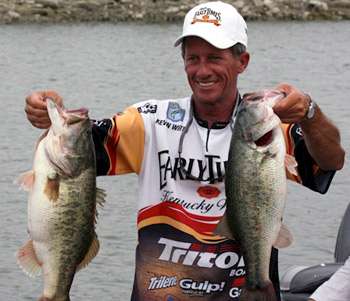
It has been theorized that 90 percent of the bass live where only 10 percent of fishermen dare to go. For many anglers, fishing deep is tantamount to space exploration. Probing the unknown depths searching for invisible cover is often much less appealing than simply dropping the trolling motor and covering visible shoreline cover.
Elite Series pro Kevin Wirth of Crestwood, Ky., is quite happy knowing that few anglers are willing to fish the unseen; however, being the consummate professional and willing teacher, Wirth is more than willing to teach a few tricks of the trade he has learned as a deep water specialist. "The first thing you need to be successful out deep is a real good topographical map of the lake you're fishing," Wirth explains.
"You also need a quality GPS unit with a topographical map card installed." With a good map and a GPS system, isolating key structure and features in deep water becomes just as easy as finding a productive laydown or shallow stump. It hasn't always been that easy, however. Wirth continues, "Years ago with an old flasher unit, it could take several days to pinpoint a solitary deep ledge or key piece of structure.
Nowadays, by using a good map and my GPS unit, I can find 20 spots in a single day." Knowing which seasonal phase bass are in, along with identifying what "deep" means for the particular lake you're fishing, are two critical aspects in finding quality deep water haunts. "Deep for one lake might be 15 feet, while at another it could be 40 feet. However, depth is irrelevant unless you know the seasonal movements of bass," Wirth says.
"For example, if the bass are fresh off the spawn, they'll be migrating up creek channels and will position on channel drops at the mouths of creeks. As they move into early summer patterns, they'll be found on the main river channels. It's all relative to the seasonal phase and how bass relate to the given migratory routes of the water you're fishing." Wirth cautions that identifying the seasonal phase and simply finding a creek channel or drop won't guarantee success.
"Just because you find a drop that goes from 10 to 30 feet on your map or electronic graph doesn't mean you have found what you're looking for," he says. "That's where a lot of people get turned around. "You have to create a mental picture of what you're fishing. That means dissecting the area to identify the key spots bass will use to migrate or hold.
You should be looking for a point or cut where bass will group up, and it's even sweeter if it has some type of cover on it." When searching for deep bass, Wirth stresses that a simplistic bait selection will pay big dividends. "In early summer, I like to keep my bait selection very basic. You need deep diving crankbaits, big worms, and a big jig." "Everything is big," Wirth adds. "You decrease your bites by throwing bigger baits, but you'll increase the quality of the fish you catch.
Ultimately, what you're after are quality bites." Once a key piece of deep water structure has been identified, dissecting it with a big bait becomes the next step. "I take a Carolina rig with a 1-ounce sinker and just drag it all over to figure out as much as I can about the area I've found," he notes. Bottom composition — whether it's made of sand, rock or mud — is important, but you don't have to be a geologist to be effective in deep water, Wirth notes. You do have to be able to count, though.
"One of my secrets is that when I'm learning a spot I'll count the bait down every time I cast it," he says. "You have to pay attention to every single thing you're doing if you want to be successful. "I'll count the bait down so that I know where I'm at in relation to the bottom contour. If I count to two before my bait hits bottom, I know that it's roughly 20 feet deep.
On my next cast, if I count to three or four, I know that I've either drifted off my sweet spot or I've found another drop." From there, Wirth maintains that fishing deep boils down to boat control and persistence. "Learning how to position your boat in relation to the structure and identify key feeding times is important," he adds. "Just because you find a drop and can see fish holding doesn't mean that they're actively feeding. "If you find the right water but you don't get bit, don't give up.
You will want to come back two or three times during the day check the spot to pinpoint when they're feeding." Learning all of the subtleties involved with successful deep water fishing isn't something that you can pick up in one afternoon. Wirth explains that ultimately, persistence pays off. "Once you start to get a few bites, you'll begin to develop confidence in fishing deep," he says.
"Over time, you'll be able to take that knowledge and apply it to any lake that has good river channels and ledges.
"Every lake is different in terms of the kinds of drops it offers," Wirth adds, "Pay attention to the details of the bottom contour, and you will catch more and better fish."
(Provided by Z3 Media)




